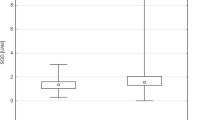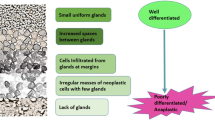Abstract
In living organism, excessive free radicals oroxidative damage which occur as a result of deficient antioxidant defensive mechanisms by the effect of endogenous and exogenous factors, influences especially developmental steps of chemically induced cancers [1, 2]. In our study, plasma malondialdehyde level (MDA) as an indicator of lipid peroxidation, erythrocyte glutathione (GSH) level as an indicator of antioxidant state, glutathione reductase (GSH-Red), glutathione peroxidase (GSH-Px), glutathione-S-transferase (GST) as an antioxidant enzymes and plasma vitamin E level were detected in patients with prostate cancer (21 males; age, 69.4 ± 4.8 years) before and after three months of antiandrogenic therapy with goserelin acetate as luteinizing hormone releasing hormone (LHRH) analogue. Healthy people evaluated as a control group (20 males; age, 63.7 ± 3.9). Erythrocyte GSH levels, the activities of GSH-Red and GSH-Px and plasma vitamin E levels were found significantly low in patients with prostate cancer when compared with the healthy subjects (p < 0.01, p < 0.05, p ≤ 0.001 and p ≤ 0.001 respectively). Plasma MDA level and erythrocyte GST activity of patient group were significantly higher than the levels of control group (p ≤ 0.001 and p ≤ 0.001 respectively). After antiandrogenic therapy erythrocyte GSH level, GSH-Red, GSH-Px activity and plasma vitamin E level were found unchanged. Significant decrease in plasma MDA level and significant increase in erythrocyte GST activity were detected in patient group (p < 0.05 and p ≤ 0.01 respectively). The study has revealed the shift in the oxidant-antioxidant balance towards oxidative state in patients with metastatic prostate cancer. Our results showed that antiandrogenic therapy increased in GST activity, decreased in lipid peroxidation.
Similar content being viewed by others
References
Barber DA, Harris SR. Oxygen free radicals, and antioxidants: a review. American Pharmacy, NS 1994; 34(9): 26–35.
Sun Y. Free radicals, antioxidant enzymes and carcinogenesis. Free Rad Biol Med 1990; 8: 583–599.
De Marzo AM, Coffey DS, Nelson WG. New concepts in tissue specify for prostate cancer and benign prostatic hyperplasia. Urology 1999; 53(Suppl 3A): 29–40.
Henderson BE, Ross RK, Pike MC. Toward the primary prevention of cancer. Science 1991; 254: 1131–1137.
Karp JE, Obiardo A, Brawley O. Prostate cancer prevention: investigational approaches and opportunities. Cancer Res 1996; 56: 5547–5556.
Stamey TA, McNeal JE. Menocarsinoma of the prostate. In: Walsh PC, Retik AB, Stamey TA, Vaughan ED, eds. Campbell's Urology, 6th edn. Pennsylvania, Philadelphia: Saunders Company, 1992: 1159–1221.
Huggins C, Hodges CR. Studies on prostatic cancer, effect of castration of estrogen and of androgen injection on serum phosphates in metastatic carcinoma of the prostate. Cancer Res 1941; 1: 293.
Fleshner NE, Klotz LH. Diet, androgens, oxidative stress and prostate cancer susceptibility. Cancer Metastasis Rev 1998–1999; 17(4): 325–330.
Ripple MO, Henry WF. Effect of antioxidants on androgeninduced AP-1 and NF-Kappas DNA-binding activity in prostate carcinoma cells. J Natl Cancer Inst 1999; 91(14): 1227–1232.
Buege SA, Aust SD. Microsomal lipid peroxidation. Methods Enzymol 1978; 12: 302–310.
Frankel S, Reitman S, Sonnerwirtb AC. Gradwahl's Clinical Laboratory Method and Diagnosis. V oil, 4Q3, 1974.
Beuther E, Duron O, Kelly BM. Improved method for the determination of blood glutathione. J Lab Clin Med 1961; 61(5): 882–888.
Paglia DE, Valentine WN. Studies on the quantitative and qualitative characterization of erythrocyte glutathione peroxidase. J Lab Clin Med 1967; 70: 158–169.
Tietz NW. Methods for the determination of erythrocyte glutathione reductase activity. In: Tietz NW, Pruden EL, Whitley RJ, Bhavagan NV, Coraway WT, eds. Text Book of Clinical Chemistry, Chapter 8. WB Saunders Company, 1986: 949–959.
Habig WH, Pabst MJ, Jacoby WB. Glutathione S-transferases: the first enzymatic step in mercapturic acid formation. J Biol Chem 1974; 249(22): 7130–7139.
Quaife M, Nevn SS. A micro method for assoy of total tocopherols in blood serum. J Biol Chem 1949; 13: 1229–1235.
Feigh DI, Reid TM, Loeb LA. Reactive oxygen species in tumorigenesis. Cancer Res 1994; 54: 1890–1894.
Rao AV, Fleshner N, Agarwal S. Serum and tissue lycopene and biomarkers of oxidation in prostate cancer patients: a casecontrol study. Nutr Cancer 1999; 33(2): 159–164.
Dogru-Abbasoglu S, Aykaç-Toker G, Koçak T, unluer E, Uysal M. Antioxidant enzyme activities and lipid peroxides in the the plasma of patients with benign prostatic hyperplasia or prostate cancer are not predictive. J Cancer Res Clin Oncol 1999; 125: 402–404.
Sobal RS, Orr WC. Relationship between antioxidants, prooxidants, and the aging process. Ann NY Acad Sci 1992; 663: 74–84.
Gbatak S, Ho SM. Age related changes in the activities of antioxidant enzyme and lipid petoxidation status in ventral and dorsolateral prostate lobes of noble rats. Biochem Biophys Res Commun 1996; 15: 222, 362–367.
Richie J. The role of glutathione in aging and cancer. Exp Gerontol 1992; 27: 615, 626.
Liehr JG. Androgen-induced redox changes in prostate cancer cells: what are causes and effects? J Natl Cancer Inst 1997; 89(1): 3–4.
Ripple M, Henry WF, Rago RP, Wilding G. Prooxidant-antioxidant shift induced by androgen treatment of human prostate carcinoma clels. J Natl Cancer Inst 1997; 89(1): 40–48.
Coles B, Ketteter B. The role of glutathione and glutathione transferases in chemical carcinogenesis. Crit Rev Biochem Mol Biol 1990; 25: 47–70.
Simone G, Tamba M, Quintiliani M. Role of glutathione in affecting the radio sensitivity of molecular and cellular systems. Radiat Phys Chem 1983; 22: 215–223.
Beutler E, Gelbart T. Plasma glutathione in health and in patients with malignant disease. J Lab & Clin Med 1985; 105(5): 581–584.
Demirtaş D, Gökta\(\underset{\raise0.3em\hbox{$\smash{\scriptscriptstyle\cdot}$}}{s} \) M, Karci B, Bilgen V, Yalçin. M. Kanserli dokuda glutatyon düzeyi araştirilmasinin önemi. Ege Tıp Dergisi 1997; 36(3–4): 109–111.
İscan M, Çoban T. Normal ve neoplastik meme dokusunda antioksidan enzimler. Klinik Geli\(\underset{\raise0.3em\hbox{$\smash{\scriptscriptstyle\cdot}$}}{s} \)im 1998; 11: 392–395.
Kudo H, Mio T. Quantitative Analysis of glutathione in human brain tumors. J Neurosurg 1990; 72: 610–615.
Perry RR, Mazetta J, Levin M, Barrancon C. Glutathione levels and variability in breast tumors and normal tissue. Cancer 1993; 72(3): 783–787.
Türkmen S, Afrasyap L, Güvenen G, Aldemir M. Selim ve habis meme hastalarinda eritrosit glutatyon düzeyleri ve glutatyon ili\(\underset{\raise0.3em\hbox{$\smash{\scriptscriptstyle\cdot}$}}{s} \)kili enzim aktiviteleri. Türk Onkoloji Dergisi 1996; 11(1): 30–33.
Battioni JP, Fontecave M, Jaquen M, Mansuy D. Vitamin E derivatives as new potent inhibitors of microsomal lipid peroxidation. Biochem Biophys Res Commun 1991; 174: 1103–1108.
Tanakol R. Antioksidan vitaminler: ha\(\underset{\raise0.3em\hbox{$\smash{\scriptscriptstyle\cdot}$}}{s} \)talikta ve saglikta önemleri. Klinik Geli\(\underset{\raise0.3em\hbox{$\smash{\scriptscriptstyle\cdot}$}}{s} \)im 1998; 11: 347–357.
Diplock AT. The role of antioxidants in clinical practice. BJCP 1990; 44(7): 257–258.
Vlajinac HD, Marinkovic JM. Diet and prostate cancer: a casecontrol study. Eur J Cancer 1997; 33(1): 101–107.
Eicbolzer M, Stabelin HB, Ludin E, Bemasconi F. Smoking, plasma vitamins C, E, retinol and carotene, and fatal prostate cancer: seventeen-year follow-up of the prospective basel study. Prostate 1999; 38(3): 189–198.
Olson KB, Pienta KJ. Vitamins A and E: further clues for prostate cancer prevention. J Natl Cancer Inst 1998; 90(6): 414–415.
Taylor PR, Albanes D. Seleniwn, vitamin E, and prostate cancer – ready for prime time? J Natl Cancer Inst 1998; 90(16): 1184–1185.
Gamick MB. Hormonal therapy in the managmeent of prostate cancer: from Huggins to the present. Urology 1997; 49(suppl 3A): 5–15.
Smith JA. New methods of endocrine management of prostatic cancer. J Urol 1987; 137: 1–10.
Cookson MS, Reuter V, Linkov I, Fair WR. Glutathione S-transferase pi (GST-pi) class expression by immunohistochemistry in benign and malignant prostate tissue. J Urol 1997; 157: 673–676.
Gonzales R, Auclair C. Superoxide dismutase, catalase, and glutathione peroxides in red blood cells from patients with malignant diseases. Cancer Res 1984; 44: 4137–4139.
Zima T, Spicka I, Stipek S, Crkovska J. Antioxidant enzymes and lipid peroxidation in patients with multiple myeloma. Neoplasma 1996; 43(2): 69–73.
Thomas DJ, Birch PJ. Glutathione-S-Transferase pi expression in transitional cell carcinoma of the bladder. Br J Urol 1993; 72: 740–743.
Author information
Authors and Affiliations
Corresponding author
Rights and permissions
About this article
Cite this article
Hacer, İ.A., Zeynep, A.A., Can, Ö. et al. The effect of prostate cancer and antianrogenic therapy on lipid peroxidation and antioxidant systems. Int Urol Nephrol 36, 57–62 (2003). https://doi.org/10.1023/B:UROL.0000032676.31470.b2
Issue Date:
DOI: https://doi.org/10.1023/B:UROL.0000032676.31470.b2




